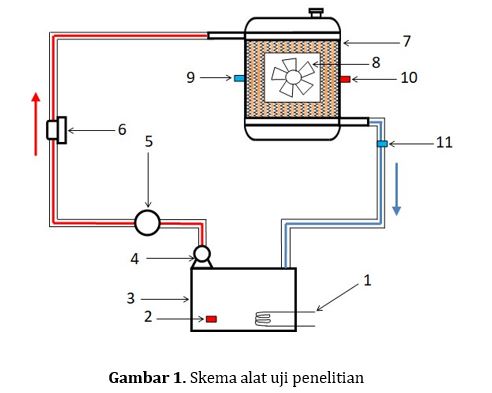Pengaruh Campuran Air-Nanopartikel CuO sebagai Coolant dan Laju Aliran terhadap Parameter Perpindahan Kalor pada Radiator
Abstract
The aim of this study was to determine the effect of volume fraction and fluid flow ratetowards the heat transfer parameters in the Honda Vario radiator cooling system. This study was conducted by using a test equipment which a radiator used as main cooling system. The inlet fluid temperature is constantly kept in accordance with the engine working temperature. Temperature measurements were carried out on variations in flowrate and fluid concentration using a digital thermometer.Variations used in fluid volume fraction are 0%, 0.1%, 0.3%, and 0.5%. While, the variation of the fluid is 12 lpm, 18 lpm, and 24 lpmmeasuredby a flowmeter. The highest change in the value of the heat transfer coefficient was found in the large volume fraction and flow rate. However, at higher volume fractions, the Reynlods number will tend to decrease. To get a better rate of heat transfer and cooling, a higher volume fraction and fluid flow is used. As for the flow variation, it usually adjusts to the vehicle user. The use of nanofluids will helpto
reduce the heat in the radiator cooling system.
References
Cengel, Y. A., dan A. J. Ghajar. 2015. Heat and Mass Transfer Fundamentals & Applications. Fifth ed. New York: McGraw-Hill. Choi, S. U. S., dan J. A. Eastman. 1995. Enhancing Thermal Conductivity of Fluids with Nanoparticles.
ASME Publications-Fed231: 99-106.
Chougule, S. S., dan S. K. Sahu. 2014. Comparative Study of Cooling Performance of Automobile Radiator Using Al2O3-Water and Carbon Nanotube-Water Nanofluid. Journal of Nanotechnology in Engineering and Medicine5(1): 010901.
Hayat, T., M. Khan., T.Muhammad., dan A. Alsaedi. 2018. On Model for Three-dimensional Flow of Nanofluid with Heat and Mass Flux Boundary Layer. Journal of Thermal Science and Engineering Applications 10(3): 031003.
Irawan, D., dan E. P.Budiana. 2013. Studi Eksperimental Perpindahan Kalor Konveksi Fluida Nano Al2O3/Ethylene Glycol pada Circular Tube di Bawah Kondisi Fluks Kalor Konstan. Mekanika11(2): 101-108.
Karimi, A., dan M. Afrand. 2018. Numerical Study on Thermal Performance of an Air-cooled Heat Exchanger: Effect of Hybrid Nanofluid, Pipe Arrangement, and Cross Section. Energy Conversion and Management 164: 615-628.
Kumar, S., G. S. Sokhal., dan J. Singh. 2014. Effect of CuO-Distilled Water Based Nanofluids on Heat Transfer Characteristics And Pressure Drop Characteristics. International Journal of Engineering Research and Applications 4(9): 28-37.
Leong, K. Y., R. Saidur., S. N. Kazi., dan A. H. Mamun. 2010. Performance Investigation of an Automotive Car Radiator Operated with Nanofluid-Based Coolants (Nanofluid as a Coolant in a Radiator). Applied Thermal Engineering30(17-18): 2685-2692.
Naraki, M., S. M. Peyghambarzadeh., S.H. Hashemabadi., dan Y. Vermahmoudi. 2013. Parametric Study of Overall Heat Transfer Coefficient of Cuo/Water Nanofluids in a Car Radiator. International Journal of Thermal Sciences 66: 82-90.
Paramananda, I. dan Prabowo. 2014. Studi Eksperimen Pengaruh Variasi Kecepatan Udara Terhadap Performa Heat Exchanger Jenis Compact Heat Exchanger (Radiator) dengan Susunan Tube Inline sebagai Pemanas. Jurnal Teknik POMITS 3(1): 91-95.
Peyghambarzadeh, S. M., S. H.Hashemabadi., M. Naraki., dan Y. Vermahmoudi. 2013. Experimental Study of Overall Heat Transfer Coefficient in The Application of Dilute Nanofluids in the Car Radiator. Applied Thermal Engineering52: 8-16.
M. S.Jamnani., dan S. M.Hoseini. 2011. Improving the Cooling Performance of Automobile Radiator with Al2O3/Water Nanofluid. Applied Thermal Engineering31(10): 1833-1838.
Putra, N., S.Maulana., R. A.Koestoer., dan A. S. Danardono. 2005. Pengukuran Koefisien Perpindahan Kalor Konveksi Fluida Air Bersuspensi Nano Partikel (Al2O3) pada Fintube Heat Exchanger. Jurnal Teknologi Edisi (2): 116-125.
Septiadi, W. N., N. Putra, dan R. Saleh. 2015. Karakterisasi Konduktivitas Termal Nanofluida Oksida Berbasis Fluida Dasar H2O. Jurnal Energi dan Manufaktur 8(2): 111-230.
Suroso, B., S. Kamal, dan B. Kristiawan. 2015. Pengaruh Temperatur dan Fraksi Volume terhadap Nilai Perpindahan Kalor Konveksi Fluida Nano TiO2/Oli Termo XT32 pada Penukar Kalor Pipa Konsentrik. Mekanika 13(2): 79-85.
Wiryanta, I. K. E. H. 2017. Studi Eksperimental Unjuk Kerja Radiator pada Sumber Energi Panas pada Rancang Bangun Simulasi Alat Pengering. Jurnal Logic 17(12): 104-108.


